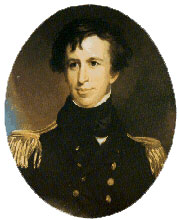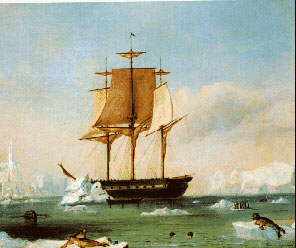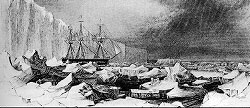During the early 1800's American sealing and whaling ships were reaping huge rewards for their efforts. Demand for furs and whale bone, oil for lamps and ambergris for use in perfumes was rapidly growing. Unfortunately, the hunting grounds off Chile and Peru were quickly diminishing and by the 1820's the New England sailors were forced more and more to the south in search of new game. As a result, penetration into Antarctic seas created diverse problems for the sailors as captains were reluctant to proclaim to other expeditions where their new hunting grounds were located. Ships suddenly found themselves in raging weather among unreported islets. A number of vessels foundered or wrecked on these islets and submerged reefs. Demands grew from the New England whalers and sealers for the US Government to sponsor exploring expeditions to the Antarctic in hopes of finding, and subsequently charting, new hunting grounds. The indifferent success of the private expedition led by Benjamin Pendleton and Nathaniel Palmer in 1829-31 could not fulfill their hopes. Upon their return, Pendleton actually asked Congress to reimburse him for his losses! On May 18, 1836, Congress passed an amendment to the Naval Appropriations Bill authorizing the President to "send out a surveying and exploring expedition to the Pacific Ocean and the South Seas," and a total of $300,000 was appropriated for the expedition. The amendment passed the Senate by a vote of 26 to 3 while in the House there was considerable opposition where the final vote was 79 to 65. The primary purpose of the expedition was to aid commerce and navigation, but it was also supposed "to extend the bounds of science and to promote knowledge". In April 1838, four naval vessels were assigned to the expedition, with the VINCENNES, a sloop of war of 780 tons, designated as the flagship. Other vessels were the PEACOCK, a sloop of war of 650 tons, the PORPOISE, a brig of 230 tons, and the store ship RELIEF. Two New York pilot boats, the 110-ton schooner SEA GULL and the 96-ton schooner FLYING FISH were purchased for the expedition to be used as survey vessels close in to shore. Wilkes was not the navy's first choice to lead the expedition. Thomas Ap Catesby Jones was originally placed in command but resigned in disgust due to delays coming from the Secretary of the Navy. The command was then offered to Commodore Shubrick, who declined. Captains Kearney and Gregory were asked and they thought it politically incorrect and so stepped aside. The next man chosen was Charles Wilkes. With little experience in sea duty, he more than made up for it in vision, intelligence and determination. His sense of mission and national pride demanded high standards of performance from himself and his crew. Unfortunately, he was not without flaws. A strict disciplinarian, he ran a taut ship..too taut for much of his crew. Many of the crew disliked him but, on the other hand, praised him for driving himself even harder. At final count, Wilkes would take with him 82 officers, nine naturalists, scientists and artists, and 342 sailors. Of the latter, only 223 would return to the United States with the expedition, or aboard other American vessels. During the voyage 62 would be discharged as unsuitable, 42 would desert, and 15 would die of disease, injury or be drowned. On August 18, 1838 Wilkes led his squadron to sea to begin the great United States Exploring Expedition.
It had been a month since she had first disappeared in the fog and while the captains were jubilant over their meeting, they nonetheless hurried to get underway as they agreed the days were growing shorter and their ships were in poor condition. The FLYING FISH would return to Orange Harbor while the PEACOCK would sail on to Valparaíso. Upon reaching Orange Harbor, the FLYING FISH encountered the PORPOISE, SEA GULL and VINCENNES already at anchor. The RELIEF was away having taken the scientists into the Straits of Magellan for a survey. Charles Wilkes was not aware of the fact that the RELIEF nearly wrecked at the entrance to the straits and that she, like the PEACOCK, had decided to sail directly to Valparaíso. Wilkes waited until April 20 for the return of the RELIEF but finally gave up and sailed the PORPOISE and VINCENNES north. Alone in Orange Harbor, the FLYING FISH and the SEA GULL awaited the return of the store ship RELIEF. On April 28, with no sign of the RELIEF, they set sail for Valparaíso. At midnight they lost contact as the FLYING FISH struggled to ride out a nine-day gale. As for the SEA GULL, she was never seen again, lost with all hands somewhere off the long Chilean coast. As with other exploratory expeditions, the Americans made use of the Antarctic winter to extend their knowledge of the Pacific island groups. The waters and coastlines of the Paumoto Islands, Tahiti, Samoa, the Marshalls and Hawaii were charted as the scientists collected botanical and geological specimens. Wilkes, once again in command of the VINCENNES, sailed from Sydney, Australia on December 26, 1839. With the PORPOISE, PEACOCK and FLYING FISH close behind, their first rendezvous was to be at Macquarie Island, 800 miles southeast of Tasmania. Seven days of good weather ushered the vessels southward but on the night of January 1, 1840 the FLYING FISH lost sight of the others. She went on, as planned, to Macquarie Island. Two days later, amid worsening weather, the PEACOCK also became separated from the group. She too reached Macquarie Island but anchored out of sight of the FLYING FISH. The VINCENNES and PORPOISE both were blown off course and subsequently passed east of the island. Wilkes decided too much time would be lost trying to fight his way back to Macquarie Island so the VINCENNES and PORPOISE continued on to their second rendezvous point where they would wait for the other two ships. Unfortunately, the FLYING FISH was leaking badly with waves breaking over her. Despite the problems, Lt. Pinkney took the ship southwards in a determined attempt to catch the others. On January 9 the VINCENNES and PORPOISE reached the second rendezvous point, Emerald Island, but lo and behold there was nothing but open water. They had fallen victim to inaccurate charts. With no time to spare, they continued south. Two days later the vessels reached what Wilkes was to refer to as "the icy barrier". They had sailed as far south as possible so they turned westwards in an attempt to find a passage through the pack ice. On January 16 the PEACOCK came into view. Concern was voiced over the fate of the FLYING FISH. The FLYING FISH actually reached the ice barrier on January 21 and struggled westwards from there in an attempt to reach the others. Admitting defeat, they turned north and arrived in New Zealand five weeks later. Reunited, the VINCENNES, PORPOISE and PEACOCK sailed west among the ice floes. On the day that the PEACOCK arrived a view of land had been shouted by the lookouts. All three vessels sighted the land and Wilkes sketched what he took to be a distant range of mountains. He named one of them Ringgold's Knoll, after the captain of the PORPOISE. Two days later, an officer aboard the PEACOCK captured an emperor penguin. The bird was found to contain 30 pebbles in it's stomach which further confirmed evidence of land, especially since the water was so shallow. On January 24 the PEACOCK was on it's own, attempting to get closer to land. Captain Hudson took his vessel into a bay crowded with floes. While attempting to avoid the large blocks of ice, the ship met with disaster. The PEACOCK crashed astern into an ice floe, the force of which threw his crew to the deck. Inspection revealed that the rudder had been torn from it's fixings. The ice closed in, grinding against the hull. Anchors were hooked on to the floes, only to be torn loose. Time and again she was rammed by great masses of ice. The stern boat was crushed. The carpenters worked throughout the night to repair the rudder. By eight o'clock on the morning of January 25, the rudder was in position again and the sloop worked her way free of the bay. Some crewmembers wished to continue on but Captain Hudson determined the PEACOCK had served her term. She turned north, reaching Sydney in the last week of February 1840.
The PORPOISE continued westwards reaching 100 degrees East on February 14, 1840. Satisfied his duty was done, the PORPOISE turned eastwards and then north to reach the Bay of Islands, New Zealand, on March 26. It is ironic that at this time Wilkes was unaware his flagship was the last of the squadron in the Antarctic. Pressing west, Wilkes drove the VINCENNES onward, sighting land on February 12. He celebrated with champagne, spent three hours taking observations, then once again sent the VINCENNES tacking west. On February 21 he confronted a wall of ice that stretched as far as the eye could see. He named it Termination Land which was changed later to Termination Ice Tongue and still later changed to the Shackleton Ice Shelf. It extends 180 miles out from the shoreline. With a number of sightings logged, a list of mountains and headlands named, the tough-minded commander of The United States Exploring Expedition took his flagship back to Sydney. Captain Hudson, aboard the PEACOCK, was there to greet him and Wilkes promptly declared discovery of the Antarctic continent which he dated as January 19, 1840. Between the spring of 1840 and the summer of 1842, Wilkes undertook a lengthy survey of the North American coast, then sailed to the Philippines and around the Cape of Good Hope. By the time he returned to the United States in 1842, his discoveries had been challenged along with his conduct as commander of the expedition. Upon his return, Wilkes learned that the English explorer James Clark Ross had sailed across some of the land the American claimed to have seen. Ross was correct, but so was Wilkes as Wilkes had experienced the effect known as looming, or polar refraction, which is a desert-like mirage that projects a perfect image relayed by the upper atmosphere, convincing the observer it is far closer than it really is. Wilkes made matters worse when he attempted to retract his recorded date of discovery as January 19, changing the date to January 16. It was his attempt to lay sole claim to discovery of the Antarctic continent since French explorer Dumont d'Urville also claimed January 19 as the date of his first view of the mainland. This matter aside, his biggest problem were charges leveled against him by his fellow officers. A Naval Court of Inquiry was convened, culminating in July 1842 in a sad and sordid court martial. All but one of the charges against him fell apart. The Court found him guilty of the illegal punishment of seamen, based on an incident that had occurred in Callao, aboard the RELIEF. Six of the crew had stolen liquor from the stores, and Wilkes had ordered them to be punished with more than the legal 12 lashes. The verdict left him fuming, but he concentrated on his efforts on writing the five-volume Narrative of his voyage. It was published in 1845, Congress allowing no more than 100 printed copies. Two of these were offered to France, two to Great Britain, two to Imperial Russia, two lodged in the Library of Congress. One each was given to the States of the Union, one to 25 designated countries, one to the Naval Lyceum, Brooklyn. Captain Hudson was given one, as was Captain Ringgold. Wilkes was allowed a single copy. Wilkes went on to continue his career in the navy. He returned to active duty in 1861 during the Civil War, but his interception of a British mail steamer almost brought Britain into the war on the side of the Confederacy. Wilkes went before a court martial once again, was found guilty and placed on the retired list. It took many years before his Antarctic accomplishments were recognized. |


